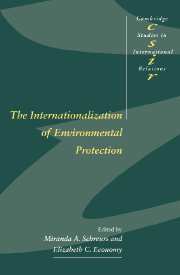Book contents
- Frontmatter
- Contents
- List of contributors
- Preface
- 1 Domestic and international linkages in environmental politics
- 2 Chinese policy-making and global climate change: two-front diplomacy and the international community
- 3 The domestic politics of global biodiversity protection in the United Kingdom and the United States
- 4 Domestic and international linkages in global environmental politics: a case-study of the Montreal Protocol
- 5 The internationalization of environmental protection in the USSR and its successor states
- 6 Domestic institutions and international environmental agendas in Japan and Germany
- 7 Zimbabwe and CITES: illustrating the reciprocal relationship between the state and the international regime
- 8 The European Union: bridging domestic and international environmental policy-making
- Index
- CAMBRIDGE STUDIES IN INTERNATIONAL RELATIONS
7 - Zimbabwe and CITES: illustrating the reciprocal relationship between the state and the international regime
Published online by Cambridge University Press: 08 March 2010
- Frontmatter
- Contents
- List of contributors
- Preface
- 1 Domestic and international linkages in environmental politics
- 2 Chinese policy-making and global climate change: two-front diplomacy and the international community
- 3 The domestic politics of global biodiversity protection in the United Kingdom and the United States
- 4 Domestic and international linkages in global environmental politics: a case-study of the Montreal Protocol
- 5 The internationalization of environmental protection in the USSR and its successor states
- 6 Domestic institutions and international environmental agendas in Japan and Germany
- 7 Zimbabwe and CITES: illustrating the reciprocal relationship between the state and the international regime
- 8 The European Union: bridging domestic and international environmental policy-making
- Index
- CAMBRIDGE STUDIES IN INTERNATIONAL RELATIONS
Summary
This chapter considers Zimbabwe and the changes it has undergone as a member of the Convention on International Trade in Endangered Species of Wild Fauna and Flora (CITES). This is done using the listing of the African elephant under CITES as a case-study. Zimbabwe is a range state, meaning it is rich in many of the wildlife species that CITES protects, including the African elephant. Zimbabwe is also a leader in the developing world, the non-aligned movement, and in broader North–South dynamics. Its self-defined political and economic interests are often antithetical to CITES strategies. Thus, although Zimbabwe has entered into the CITES agreement, it has often been opposed to the behavior changes that the regime has expected.
CITES, an established and widely recognized international environmental agreement, was formed in 1973 and, as of 1995, had 128 national signatories. CITES' purpose is to regulate international trade in animals, plants, and their products in order to prevent or mitigate species extinction, where international trade plays a major role in threatening that species. While CITES regulations are formulated at the international level, they are implemented nationally. Zimbabwe became a party to CITES in 1981.
CITES regulates trade in threatened and endangered species through listings in its three appendices. Appendix I lists species considered to be endangered, and generally bans commercial trade in those species. Appendix II includes threatened species, and subjects their trade to a system of permits and quotas. A third appendix is used by member states to list species threatened only in their particular jurisdictions; the protection of these species requires the cooperation of their trading partners.
- Type
- Chapter
- Information
- The Internationalization of Environmental Protection , pp. 162 - 187Publisher: Cambridge University PressPrint publication year: 1997
- 2
- Cited by

